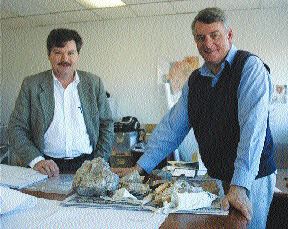Aurora’s timely move into New Zealand has added to its portfolio of gold properties in Western Australia, and reflects an appreciably improved political climate for prospecting on New Zealand’s North Island, with its wealth of untapped potential for epithermal gold.
Companies like Aurora are part of a new resources boom, spurred by government data showing potential epithermal targets in the Northlands region on the North Island. Aurora’s field work revealed that its Hazelwood prospect, in particular, has two targets worthy of more advanced work. These, the Backyard and Toolshed prospects, are 2 km apart.
Compared with Australia, where there are frequent problems dealing with Aboriginal land claims, the Kiwi progress, from acquisition to advanced exploration, is handled with exceptional care.
The dairy farm containing the main Hazelwood prospects is owned by Russian businessmen of some prominence, who so far have invested roughly NZ$100 million in dairy, tourism and real estate projects throughout the country.
Aurora struck a joint venture with Emerald Mining, a unit of the Emerald Group, owners of the dairy. The Russians can earn a half-stake by spending up to NZ$10 million on exploration and development within four years. In year one (which started in June), it must spend NZ$2 million on exploration, with Aurora managing the program.
By New Zealand and even Australian standards, this is a healthy budget and will carry Aurora through the critical early, high-risk proving work. Drilling on Backyard is expected to begin later this year.
Aurora’s Managing Director Robert Taylor likens Backyard’s structural setting to the Waihi mine, which has been one of New Zealand’s great gold mines, having produced more than 7.5 million oz. gold and 26 million oz. silver over 120 years of operation.
Backyard and Toolshed comprise only about 5.5 sq. km of Aurora’s 1,013 sq. km of land holdings in New Zealand, most of which is in the Northland region. This does not include Macraes West, a prospect relatively close to the country’s biggest gold mine:
Unlike most other gold targets in New Zealand, Hazelbrook is a virgin target that illustrates the potential for new gold and gold-silver mines within the volcanic belts of the North Island.
(A new gold mine producing some 100,000 oz. gold-equivalent annually could be worth more to New Zealand in terms of export revenue than that of the entire the wine industry.)
Field work at Backyard has revealed at least 17 veins associated with quartz — the prime host of epithermal gold-silver — boulders over a known strike of 600 metres and ranging from 100-400 metres in width.
Managing director Robert Taylor told The Northern Miner that the system could extend further, as evidence suggests it continues under cover. Float samples from Backyard grade up to 7.8 grams gold per tonne.
In a quarterly report published in March, Aurora said a new gold-in-soil anomaly at Toolshed returned encouraging values over 400 metres. The joint-venture agreement with Emerald Mining, halves the search risk for Aurora, and by having its landholder as a partner, it limits any issues that could arise over land access.
Aurora’s progress will be closely watched by a planned Canadian float,
The package includes the Puhipuhi property in the Northland region, formerly held by OceanaGold, as well as the South Island leases, which include ground in, and near, the Reefton goldfield where OceanaGold is conducting a redevelopment project.
A third prospect, dubbed Rise and Shine, north of the Macraes gold mine, is a farm-in with OceanaGold.
— The author is a freelance writer based in Perth, Western Australia.


Be the first to comment on "Aurora turning cheese into gold in New Zealand"